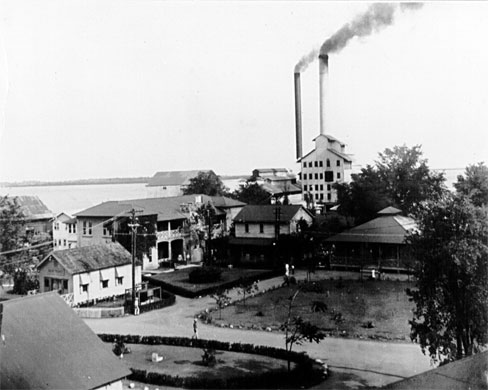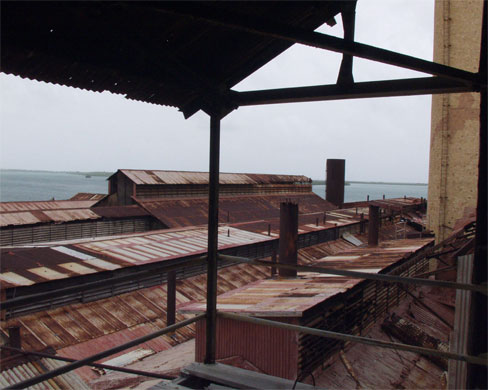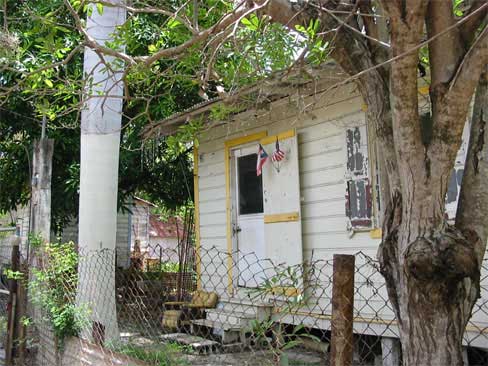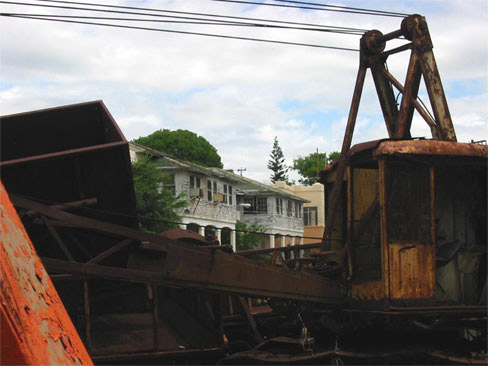Research Report
A Multidisciplinary Approach to Investigating the Industrial Heritage of Puerto Rico: Research at the National Register Site of Central Aguirre
by Sam R. Sweitz
Puerto Rico has held a unique relationship with the United States since its acquisition by the U.S. in the aftermath of the Spanish-American War of 1898. The economic ties that have bound the fortunes of the island to both private and federal investment from the mainland have been fundamental to this U.S.-Puerto Rican symbiosis. The influx of capital following annexation had a particularly profound effect on the then moribund Puerto Rican sugar industry, initiating the decades-long preeminence of sugarcane as the island's most powerful economic and social force.
The establishment of the central system, meaning centralized industrial sugar mills associated with company towns, in the early 20th century represented an important new chapter in the socio-economic development of the island, one that impacted the lives of generations of working-class individuals. The highly industrialized central, emblematic of U.S. economic, political, and social hegemony on the island, was associated with the latest in productive technology. Equally important, the central also introduced new ideas concerning social organization and community through contemporary proscriptions on paternalism, social welfare, and the Americanization of working-class individuals. These proscriptions reified principles of family, morality, opportunity, and class/ethnic divisions among workers within the social and physical landscapes of the planned company towns that were built to support the sugar production of the centrales.
Planned communities like the National Register site Central Aguirre on the south-central coast of the island represent late 19th-century and early 20th-century conceptions of how industry and community should be integrated. Central Aguirre was the first American-built mill and company town in Puerto Rico. Production commenced with the harvest of 1900 and ceased in 1990. It was intended, and was designed, to affirm the power and progressiveness of the Central Aguirre Sugar Company. (Figure 1) However, Central Aguirre was also home (and continues to be home) to generations of Aguirreños who, in spite of their residence at the beneficence of the company, formed strong communal bonds. These bonds fostered an interrelated sense of place and identity. As the last remaining, relatively intact example of such an engineered community on the island, Central Aguirre offers a rare opportunity to explore the historical development and evolution of engineered communities within the cultural environment of Puerto Rico. Moreover, research at Central Aguirre provides a backdrop on which broader aspects of Puerto Rican, as well as U.S., industrial and social history may be understood.
 |
Figure 1. An early view of the mill at Central Aguirre during harvest season, circa 1920s. (Courtesy of Jobos Bay National Estuarine Research Reserve.) |
The Company of Town of Central Aguirre
For the past three years Michigan Technological University has been conducting a multi-disciplinary research effort at Central Aguirre that has focused on archival work, oral history interviews, and spatial analyses to discover and record the historical evolution of community within an industrial space. The story of sugar production and community building at the site revolves around issues of colonization, Americanization, class and ethnic segregation, identity, and sense of place. These topics have informed our research on industrial and working-class heritage, revealing the poignancy of life in a community that continues to identify itself with a sugar producing past while suffering the economic and social dissolution of being a post-industrial place.(Figure 2) Thus the work at Central Aguirre has been oriented towards understanding how working-class heritage is related to the creation of place-specific identities, and more particularly, the juxtaposition between how the landscape of the company town was conceived of by the company and how it was then perceived by those who lived in the town. As researchers, we are interested in how the implicit negotiation between the two perspectives led to the everyday experiences that ultimately made a place of production a community.
 |
Figure 2. Looking out over the rusting corrugated metal roofs of the now derelict Central Aguirre mill. (Sam Sweitz, photographer.) |
Archival research and spatial analyses on the history and design of the industrial community reconstruct the framework on which everyday life took place. In building the company town, the Central Aguirre Sugar Company conceived of a physical and social landscape arranged for the production of sugar and the reproduction of a workforce. The hierarchical social and economic representations that ordered this production were encoded within the landscape and became integral to the ways in which individuals and groups perceived and negotiated their everyday lives. The landscape was designed to maintain the expected social and economic relationships within the community through spatial segregation in the form of prohibitions which designated the appropriate spaces for particular activities or behaviors and subdivided space into areas restricted to one group or another.
The primary divisions at Central Aguirre were represented by ethnic and class distinctions embodied in a hierarchical landscape divided into two neighborhoods: Aguirre and Montesoria. The Aguirre and Montesoria neighborhoods differ in size, layout, and style of architecture; in lot size and density; and by topographic advantages. Divisions occurred first along ethnic and class distinctions between Americans and Puerto Ricans, and then between upper-middle class Puerto Ricans—known colloquially as "acomodados" (privileged people) or "blanquitos" (snobby white people)—and working-class Puerto Ricans. The Aguirre neighborhood, with its large houses and spacious lots in the hills overlooking the mill, was intended for American and upper-middle class Puerto Rican executives and administrators. The efficient houses of Montesoria were built on prescribed lots situated on the flats next to the mill and Jobos Bay and were home to working-class Puerto Ricans.(Figure 3)
 |
Figure 3. An example of a typical criollo (creole) style worker’s house in the Montesoria neighborhood of Central Aguirre. (Sam Sweitz, photographer.) |
Oral interviews conducted at Central Aguirre have elaborated on the community divisions gleamed from archival and spatial analyses. These interviews provide insight into how individuals negotiated daily life within the community. As a company town, life inside the mill community was subject to the direct influences of the company and the pervasive acculturative forces represented by imported elements of material culture, expressive culture, and surveillance. The processes of acculturation at Central Aguirre were aimed at creating a moral work force that was stable, disciplined, and loyal to the company.
Discipline within the community might be enforced openly when necessary, but the company often relied on more subtle means of compelling self-discipline. The ever present potential for being observed, whether directly by company management or through community informants, helped to internalize the moral and disciplinary message of the company. There were consequences for non-compliance. The most drastic of these was the loss of employment. In addition to loss of income, it also meant the loss of company provided housing, and, as a result then, the loss of one's reason for belonging in the community and one's identity as an Aguirreño.
Incorporating archival research, spatial analyses, and oral history into a single research program has allowed a synthetic understanding of the importance of place and identity in interpreting the industrial heritage of Central Aguirre. Answering the question of what it means to be an Aguirreño is crucial to any understanding of the working-class heritage of those who labored and lived at the central. The sense of place engendered by the continuing negotiation and renegotiation of spaces designed explicitly for production, informed and continues to inform the lived experiences of individuals who imbued this space with their own significance and memories. The words informants use to describe their lives in the central, and the memories they collectively share, reinforce the idea that the working-class identity of the community is in many ways directly related to the sense of distinctiveness, continuity, self-esteem, and self-efficacy individuals have drawn from being in that place.(1)
The voices of the people of Central Aguirre attest to the dynamic role that a productive place plays in the creation of individual and group identities. The working-class identity of generations of Aguirreños is represented in the cumulative and shared experiences of those who called and continue to call Central Aguirre home. Recognition of the collective nature of identity in Central Aguirre has demonstrated to us as researchers that working-class heritage is not something of the past. Rather, the sense of place Aguirreños express in describing their attachment to their community is a shared heritage that guides everyday experience, a heritage that is best understood as a continuing dialogue with the past.
Continuing Research at Central Aguirre
Future research plans at Central Aguirre include the introduction of an interdisciplinary field school, archeological research, and the implementation of an elementary school level outreach program. The interdisciplinary field school we envision will provide students with the unique opportunity to gain experience in archival research, techniques of spatial analysis, oral history, and archeological excavation. The field school and new archeological information will build on earlier research, extending our understanding of the historical trajectory of production and community on this landscape. It is expected that the initiation of archeological investigations conducted on the grounds of the former Hacienda Aguirre will bring about the recovery of material culture that will give "voice" to those individuals (including those who were enslaved) who labored at this place in the 19th century, furthering our understanding of the evolution and impact of the sugar industry on the island.
The proposed elementary outreach program will involve students in designing a multidisciplinary research project that they will then conduct within the community. This project will include aspects of interviewing, mental mapping, photography, and other community-based forms of study that will encourage interaction between students and multiple generations of community members. The elementary outreach program will go a long way towards achieving our paramount research goal for the Central Aguirre program, which is to create a multivocal research program that addresses the social and economic needs of the community going forward.(Figure 4) It is hoped that the integrated program of research described here will broaden our understanding of the heritage of those who labored in the sugar industry in Puerto Rico while at the same time creating a more sustainable future for all Aguirreños.
 |
Figure 4. The administrative office of the Central Aguirre Sugar Company sits abandoned among the rusting ruins of the central awaiting reuse in a post-industrial Aguirre. (Sam Sweitz, photographer.) |
About the Author
Sam Sweitz is Assistant Professor in the Social Sciences Department at Michigan Technological University. For more information about his ongoing research of Puerto Rico's industrial heritage, please contact him at srsweitz@mtu.edu.
Note
1. Clare Twigger-Ross and David Uzzell have used Glynis M. Breakwell's principles of identity, including the variables of distinctiveness, continuity, self-esteem, and self-efficacy to discuss the importance of place in individual identity formation, in their work "Place and Identity Processes," Journal of Environmental Psychology 16 (1996): 205-20. For Breakwell's theories, see Coping with Threatened Identity (London: Methuen, 1986) and "Processes of Self-Evaluation: Efficacy and Estrangement," in Social Psychology of Identity and the Self Concept, ed. Glynis M. Breakwell (Surrey: Surrey University Press, 1992).
